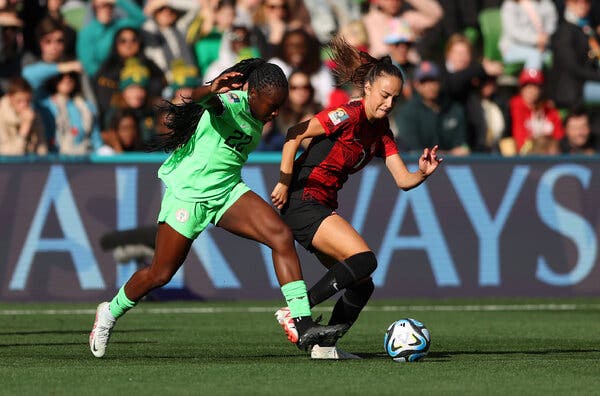
Women’s World Cup: Canada Ties Nigeria, but Laments Missed Penalty

Not much of what led to this World Cup has gone the way Canada’s women’s team might have wanted. Fights over funding and paychecks and support. A key player lost to injury. A curious absence of match preparation. Nigeria, embroiled in its own bitter pay dispute, probably would say the same.
Both teams had declared they were setting those things aside this week now that the games were here. “Forget about the distractions, and just focus on the game,” the Nigeria striker Asisat Oshoala, who plays for Barcelona, said earlier this week. But it was perhaps fitting, or at the very least unsurprising, that the first steps of the tournament — a scoreless draw on Friday in Melbourne — will leave neither team entirely satisfied.
Canada, which saw its soccer matriarch Christine Sinclair fail to convert a second-half penalty kick, will leave believing it could have, and maybe should have, won. Nigeria, which piled up fouls (16) but not shots on goal (1), will be wondering how it will adapt to the loss of midfielder Deborah Ajibola Abiodun; she was sent off late in the second half for a foul that was upgraded to red from yellow after a video review.
The emotions of the moments after the final whistle suggested both teams were processing the result differently. Nigeria’s goalkeeper, Chiamaka Nnadozie, who had saved the penalty, dropped to her knees as if celebrating a memorable victory. Sinclair, substituted for only the second time in six World Cups, sat glumly on the bench as Canada Coach Bev Priestman whispered encouragement in her ear, perhaps in vain.
“Christine Sinclair has scored many, many, many goals for this country and I’m sure the fans, the team and everyone can forgive missing a penalty kick,” Priestman said.
About the only winner on Friday, it seemed, was Australia. Its victory over Ireland on Thursday, combined with the Canada-Nigeria draw, left it atop Group B. Given that it is dealing with its own crisis of confidence after losing Sam Kerr, that will be a comfort. For now.

Five games, five penalties.
If the World Cup’s opening games have been slow to deliver in one statistic — until Spain started to pummel Costa Rica, the tournament had produced only two goals from open play — it is overproducing in another: penalty kicks.
Each of the first five games of the tournament has produced one. A handball by Norway. A shove by Ireland. A trip by Nigeria. A foul by Costa Rica. A very literal interpretation of the rules in Philippines-Switzerland.
Video assistant referees have played a role in several of the calls. The ball that hit the hand of Tuva Hansen of Norway late in its loss to New Zealand, for example, was spotted by the V.A.R. and relayed to the on-field referee, who had not whistled a penalty in real time. The penalties awarded to Canada and Switzerland, too, were only confirmed after officials took a second look.
Being awarded a penalty and scoring a penalty are two distinct actions, however. Only two of the five called were then converted into goals.
The upside of all those early trips to the spot? One of them has produced the play of the tournament so far: Chiamaka Nnadozie’s diving save of Christine Sinclair’s attempt in Nigeria’s draw with Canada in Melbourne.

On the eve of his country’s meeting with the United States, the reporter from Vietnam got right to the point.
“Are you going to crush us like you did Thailand four years ago?” he asked Coach Vlatko Andonovski and the U.S. co-captain Lindsey Horan.
Andonovski didn’t give a direct answer. Decorum meant he couldn’t say what many have been thinking (that the U.S. team might, in fact, crush Vietnam). But Andonovski also didn’t know the answer.
Not even he knows how a new combination of U.S. players will work together. Or how Vietnam, in its first World Cup, will fare in its first game, scheduled for Saturday morning in New Zealand at a time that Americans will be able to watch on Friday night (at 9 p.m. Eastern).
What he and Horan do know, however, is that the world of women’s soccer has changed since the United States thumped Thailand, 13-0, at the last World Cup.
“There are not easy games that before you were just like, oh, this is going to be 6, 7-0 or whatever,” Horan said. “it’s not how it is anymore.”
Fears that an expanded tournament, now at 32 teams, might usher in more routs haven’t come true, at least not yet. The first two World Cup debutantes to take the field, Ireland and the Philippines, both lost, but in close games.
But the U.S. team isn’t the same as it was four years ago, either. Horan was reminded of that on Thursday morning when Becky Sauerbrunn, the team’s longtime captain who is out with an injury, texted her to wish her good luck. Sauerbrunn, Horan said, told her to embrace her new role as captain.
Horan and her co-captain, Alex Morgan, lead a team that includes 14 World Cup rookies of its own. It is their job to show the newcomers how to win games under pressure, to live up to the expectations of a dynasty and to do it with the whole world watching.
Andonovski said Thursday that he would have the full roster at his disposal. Rose Lavelle and Megan Rapinoe, who have been nursing injuries, might see limited minutes. Julie Ertz, who has rushed back after having her first child last year, is “100 percent.” It is very important, he said, for him to see the team connect on the field after it hasn’t played together, with all of its parts, in a while.
“Regardless of what happened in the past, it is important for us to win this tournament, to do well in this tournament,” he said.
He also didn’t give a direct answer to another question from a different reporter from Vietnam, likely because it addressed a subject he doesn’t want to think about.
That reporter asked, “What will happen if U.S.A. cannot win against Vietnam?”
One of the toughest parts of watching the Women’s World Cup this year may be keeping track of all the time zones in Australia and New Zealand where the matches are being played.
That will require lots of math and, in some cases, middle-of-the-night alarms. So let us help!
Our friends at The Upshot have created a handy tool that allows you to see the World Cup schedule easily, accurately and in the time zone of your device’s location.

The third time around, Megan Rapinoe’s reaction to a potentially career-ending knee injury went no further than an eye roll. She had torn her anterior cruciate ligament. She could reel off the recovery schedule from the top of her head. She could see, crystal clear, the next nine to 12 months spooling out in front of her.
The surgery, the painstaking rehab, the grueling weeks in the gym, the anxious first steps on the turf, the slow journey back to what she had once been. As she considered it in 2015, she felt something closer to exasperation than to despair. “I was like, ‘I don’t have time for this,’” she said.
The first time had been different. She had torn the anterior cruciate ligament in her left knee at age 21, when she was a breakout star in her sophomore year at the University of Portland. At that time, she felt what she called “the fear” — the worry that it might all be over before it had begun.
Over the last year or so, that fear — and the searching questions it prompts — has coursed through women’s soccer. The sport has at times seemed to be in the grip of an epidemic of A.C.L. injuries, one so widespread that at one point it had sidelined a quarter of the nominees for last year’s Ballon d’Or.
Vivianne Miedema of the Netherlands, whose knee injury will keep her out of the World Cup, pointed out that, this season alone, almost 60 players in Europe’s five major leagues had torn their A.C.L.s. “It is ridiculous,” she said earlier this year. “Something needs to be done.”
Working out precisely what that might be, though, is more complicated than anyone would like.

Sports are often about gaps: talent gaps, experience gaps, compensation gaps. And in the weeks and months before the Women’s World Cup that began on Thursday in Australia and New Zealand, the players on the U.S. national women’s soccer team have found an unlikely bond in jokes, jabs and stories related to what may be their most notable feature: a generation gap.
The team’s oldest player is Megan Rapinoe, 38, the iconic athlete who recently announced that she would retire after this World Cup and the end of her current professional season. The youngest is Alyssa Thompson, who is 18, just graduated high school and still lives with her parents. At least three of Thompson’s teammates — Morgan, Crystal Dunn and Julie Ertz — have children of their own.
Thompson said that her older teammates sometimes play music that she doesn’t recognize, but that the different age groups find a middle ground with Cardi B. Sophia Smith, a 22-year-old forward, said she does recognize the music, though by genre, not by artist. “They sound like what my parents listen to,” she said.
Smith admitted last month that she never has used a CD player and that she refuses to watch TV shows or movies if the video quality is “grainy.” One exception: videos of the 1999 Women’s World Cup final, a historic victory by the United States that spurred rapid growth of women’s soccer in America. Unlike some of her teammates, Smith has no memory of watching that team play — the final was played more than a year before she was born.



